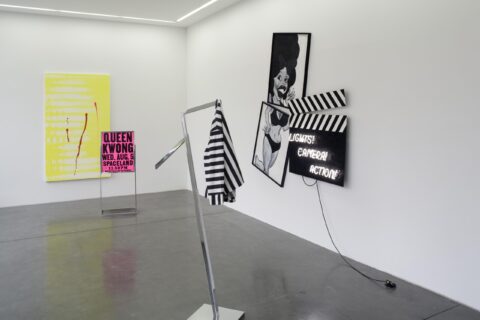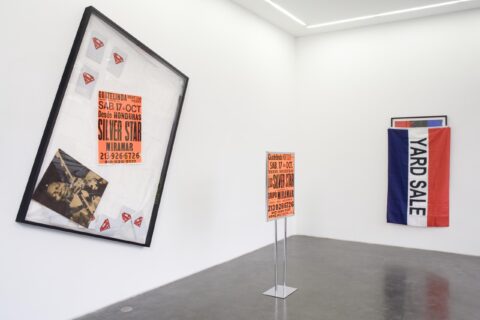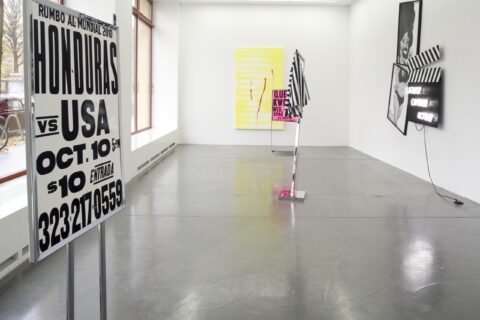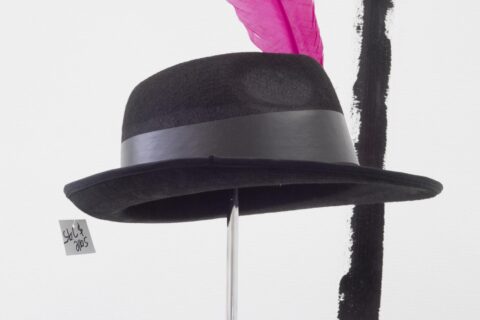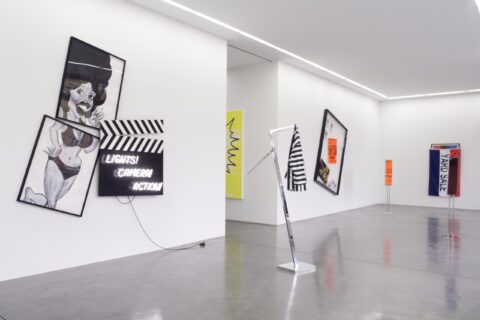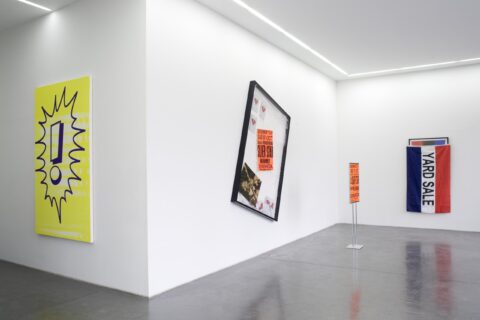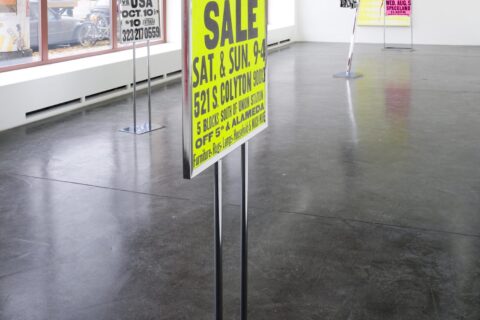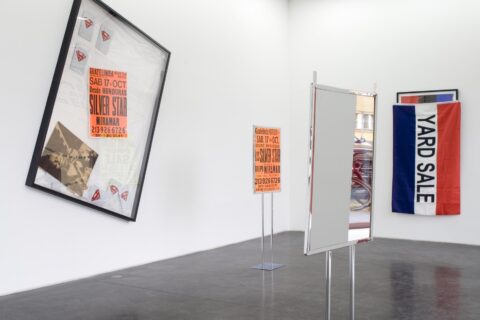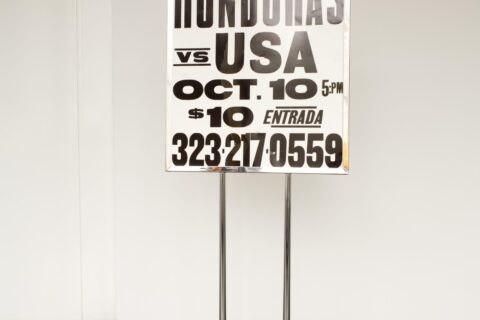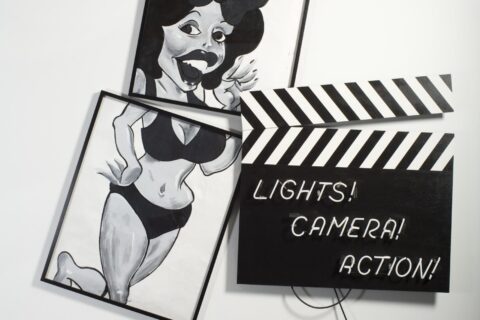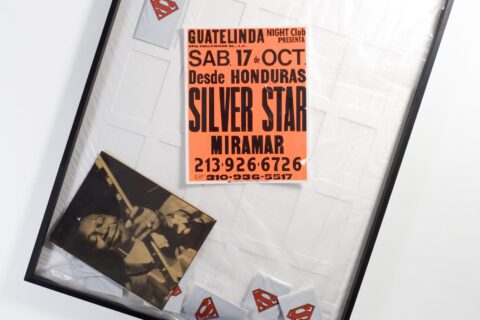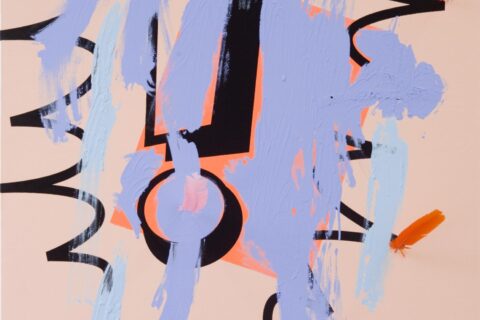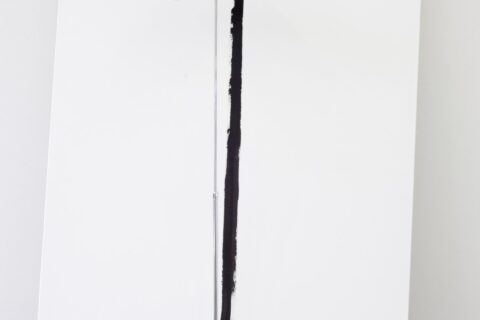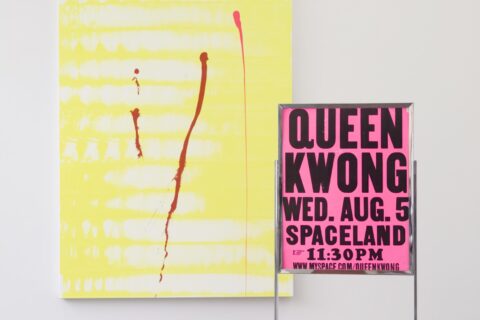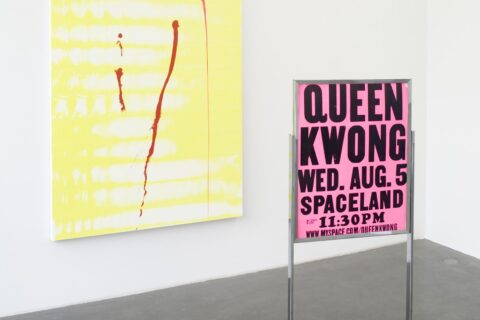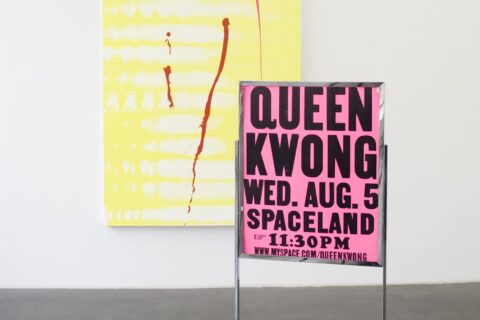Kathryn Andrews Frankie Goes to Bollywood
07/11/2009 – 20/12/2009
Eröffnung: Freitag, 06. November 2009, 19-22 Uhr
Ausstellung: 07. November - 20. Dezember 2009
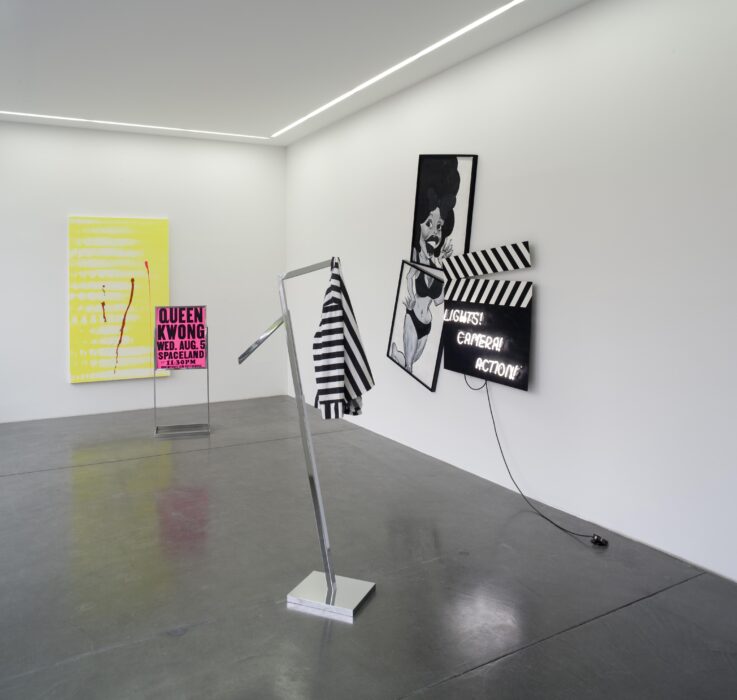
Kathryn Andrews
Installationsansicht
„Frankie Goes to Bollywood“, 2010
Galerie Christian Nagel, Berlin
Photo: Ludger Paffrath
Installationsansicht
„Frankie Goes to Bollywood“, 2010
Galerie Christian Nagel, Berlin
Photo: Ludger Paffrath
Installationsansicht
„Frankie Goes to Bollywood“, 2010
Galerie Christian Nagel, Berlin
Photo: Ludger Paffrath
Installationsansicht
„Frankie Goes to Bollywood“, 2010
Galerie Christian Nagel, Berlin
Photo: Ludger Paffrath
Installationsansicht
„Frankie Goes to Bollywood“, 2010
Galerie Christian Nagel, Berlin
Photo: Ludger Paffrath
Installationsansicht
„Frankie Goes to Bollywood“, 2010
Galerie Christian Nagel, Berlin
Photo: Ludger Paffrath
Installationsansicht
„Frankie Goes to Bollywood“, 2010
Galerie Christian Nagel, Berlin
Photo: Ludger Paffrath
Kathryn Andrews
„Hollywood Export II“, 2009
Acryl auf Leinwand, verchromter Stahl, gefundener Hut, Feder
Photo: Ludger Paffrath
„Yard Sale“, 2009
Siebdruck (Unikat), Holz, Messing, gefundene Flagge, Poster
ca. 170 x 93 cm
Photo: Ludger Paffrath
„Yard Sale“, 2009
Siebdruck (Unikat), Holz, Messing, gefundene Flagge, Poster
ca. 170 x 93 cm
Photo: Ludger Paffrath
Installationsansicht
„Frankie Goes to Bollywood“, 2010
Galerie Christian Nagel, Berlin
Photo: Ludger Paffrath
Installationsansicht
„Frankie Goes to Bollywood“, 2010
Galerie Christian Nagel, Berlin
Photo: Ludger Paffrath
Installationsansicht
„Frankie Goes to Bollywood“, 2010
Galerie Christian Nagel, Berlin
Photo: Ludger Paffrath
Installationsansicht
„Frankie Goes to Bollywood“, 2010
Galerie Christian Nagel, Berlin
Photo: Ludger Paffrath
„2010“, 2009
verchromter Stahl, gefundenes Poster
156 x 56 x 25,5 cm
Photo: Ludger Paffrath
“Ciao Frankie! Break A Leg!“, 2009
Holz, Neon, Acryl auf Leinwand,
ca. 225 x 200cm
Photo: Ludger Paffrath
„Hollywood Conclusion“, 2009
Holz, Plastik, Pappe, verchromter Stahl, gefundene Poster, Comicbücher
141,5 x 195,6 cm
Photo: Ludger Paffrath
Kathryn Andrews
„Hollywood Conclusion“, 2009
Holz, Plastik, Pappe, verchromter Stahl, gefundene Poster, Comicbücher
141,5 x 195,6 cm
Photo: Ludger Paffrath
Kathryn Andrews
„Hollywood Conclusion“, 2009
Holz, Plastik, Pappe, verchromter Stahl, gefundene Poster, Comicbücher
141,5 x 195,6 cm
Photo: Ludger Paffrath
„Hollywood Export I“, 2009
Acryl auf Leinwand, Federn
210 x 124 cm
Photo: Ludger Paffrath
„Hollywood Export II“, 2009
Acryl auf Leinwand, verchromter Stahl, gefundener Hut, Feder
Photo: Ludger Paffrath
„King Kong (Remake)“, 2009
Acryl auf Leinwand, verchromter Stahl, gefundenes Poster
Photo: Ludger Paffrath
“King Kong (Remake)”, 2009
Acryl auf Leinwand, verchromter Stahl, gefundenes Poster
Photo: Ludger Paffrath
“King Kong (Remake)”, 2009
Acryl auf Leinwand, verchromter Stahl, gefundenes Poster
Photo: Ludger Paffrath
Kathryn Andrews
„King Kong (Remake)“, 2009
Acryl auf Leinwand, verchromter Stahl, gefundenes Poster
Photo: Ludger Paffrath
„New Roles“, 2009
verchromter Stahl, geliehenes Kostüm
ca. 185 x 95 cm
Photo: Ludger Paffrath
„Starmacht“, 2009
Acryl auf Leinwand, 2009
210 x 124 cm
Photo: Ludger Paffrath
Press Release
In Kathryn Andrews’ erster Einzelausstellung Frankie Goes to Bollywood in der Galerie Christian Nagel, Berlin befindet sich der Betrachter inmitten eines Konglomerats aus Bildern, Collagen, Skulpturen und geliehenen Hollywoodrequisiten. Die scheinbar autonomen Objek-te werden allesamt in einen Raum gestellt, wo sie untereinander Verbindungen eingehen und dadurch eine neue Identität gewinnen. Gemeinsamkeiten optischer oder linguistischer Qualität, seien sie noch so klein, setzen die einzelnen Objekte in ein Netz aus Beziehungen.
Dieses Netzwerk existiert jedoch nicht als zuvor bereits festgelegtes Koordinatensystem, das über all die Objekte gelegt werden kann und somit jedes einzelne in eine Position zwingt, sondern verweist in seiner Dynamik auf die Veränderlichkeit von Erscheinungen und Bedeu-tungen. Verändert der Betrachter seine eigene Position im Raum, seinen Blickwinkel und somit seine Perspektive, entstehen immer wieder neue Konstellationen.
Andrews’ dynamische Gruppierungen minimieren ihre Künstlerautorität als allwissender Au-tor, der determinierte Situationen schafft, die nur auf eine Weise funktionieren. DIe Titel der Arbeiten unterstreichen ebenfalls dieses Konzept. Zwar integrieren sie jedes Objekt in ein narratives Ganzes, erklären aber nicht die Objekte, sondern erweitern das Netz der Bedeu-tungsmöglichkeiten. Ziel der Künstlerin ist es, zahlreiche Kontexte zu produzieren, um Be-deutungen zu multiplizieren.
Die Menschen neigen dazu, die Dinge nach „Zwecken der Vernunft“ zu einem logischen Ganzen zu fügen, um einen einheitlichen Sinn zu stiften. Kathryn Andrews unterläuft in ihrer Ausstellung dieses System, um auf dessen Vergänglichkeit hinzuweisen, denn jede zu Recht gelegte Sinnkonfiguration ist nur eine temporäre Konstruktion. Anstatt die Ausstellung einem diskursiven Ganzen zu unterwerfen, setzt Andrews den Betrachter absurden Situationen aus, die vor Augen führen, dass jede Sinngebung kontextabhängig ist und im Austausch mit der jeweiligen Wahrnehmung eines Individuums steht.
Die Künstlerin bietet also keine endgültige Lösung, sondern schildert dem Betrachter eine Situation, die wiederum nur eine von vielen ist:
“Frankie Goes to Bollywood is the mise-en-scène of the last Hollywood days of the American-singer-and-actor Frankie Avalon in the late 1980s. Facing a career slump following his big-comeback surf movie Back to the Beach, Avalon has decided to move to Mumbai, where he’s been offered a supporting role in a promising Bollywood blockbuster. Avalon must now sell off his possessions, part with old friends and the place he has long called home…Farewell Hollywood!” (Kathryn Andrews)
In Kathryn Andrews’ first solo exhibition Frankie Goes to Bollywood at Galerie Christian Nagel, Berlin the viewer finds himself amongst a conglomerate of paintings, collages, sculptures and a borrowed Hollywood prop:
“Frankie Goes to Bollywood is the mise-en-scène of the last Hollywood days of the American-singer-and-actor Frankie Avalon in the late 1980s. Facing a career slump following his big-comeback surf movie ‘Back to the Beach’, Avalon has decided to move to Mumbai, where he’s been offered a supporting role in a promising Bollywood blockbuster. Avalon must now sell off his possessions, part with old friends and the place he has long called home…Farewell Hollywood!” (Kathryn Andrews)
In the exhibition Andrews has playfully placed seemingly autonomous objects in situations where they form many links to other objects through optical and linguistic resonance. Each object exists in a network of connections undermining the idea that an artwork has a fixed appearance and a given set of meanings. As the viewer changes his position in the gallery, his angle of view, different constellations of objects emerge. He finds himself in new configurations.
Andrews’ groupings minimize the concept of the artist as all-knowing author who sets up predefined situations from which a specific sense should be understood. Even her titles point to this. They tie each object into an overarching narrative, but one that is fictional. Instead of literally explaining the objects the titles further anchor them to yet another network of meaning. Man always tries to put things together in “accordance with the end of reason”[1] to create sense. Andrews works points to this. Instead of authoritatively proposing one logic for the exhibition, she proposes absurd ones that can easily be discarded. Andrews ultimately is after the very mechanisms by which sense is constructed, that all meaning is context dependent, and that every artwork’s appearance is governed by individual consciousness which is formed in reaction to being in a given time and place.
[1] Immanuel Kant: Critic of pure reason.
